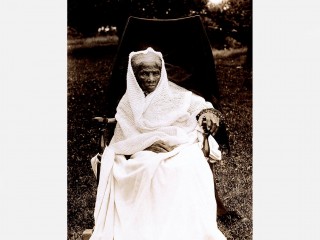
Harriet Tubman biography
Date of birth : -
Date of death : 1913-03-10
Birthplace : Dorchester County, Maryland
Nationality : African-American
Category : Historian personalities
Last modified : 2010-04-19
Credited as : Abolitionist, Humanitarian, Slavery
75 votes so far
Reared in slavery, she married a free black, John Tubman, in 1844. He opposed her plans to flee north, so she escaped alone via the Underground Railroad in 1849, and over the next decade she led nearly 300 Maryland slaves to safety, including several siblings and her elderly parents.
Originally named Araminta, or “Minty”, known as “the Moses of her people,” Harriet Tubman was devoutly religious and a believer in decisive action. She helped John Brown organize his 1859 raid on Harper’s Ferry, Virginia, but was prevented by illness from accompanying him.
When the American Civil War began, Tubman worked for the Union Army, first as a cook and nurse, and then as an armed scout and spy. The first woman to lead an armed expedition in the war, she guided the raid on the Combahee River, which liberated more than seven hundred slaves. After the war, she retired to the family home in Auburn, New York, where she cared for her aging parents. She was active in the women's suffrage movement until illness overtook her and she had to be admitted to a home for elderly African-Americans she had helped open years earlier.
In her later years, living in Auburn, New York, she helped support relatives and other former slaves, and raised money for freedmen’s schools and a home for elderly blacks.
Legacy
Harriet Tubman, widely known and well-respected while she was alive, became an American icon in the years after she died. A survey at the end of the twentieth century named her as one of the most famous civilians in American history before the Civil War, third only to Betsy Ross and Paul Revere. She inspired generations of African Americans struggling for equality and civil rights; she was praised by leaders across the political spectrum.
When she died, Tubman was buried with military honors at Fort Hill Cemetery in Auburn. The city commemorated her life with a plaque on the courthouse. Although it showed pride for her many achievements, its use of dialect ("I nebber run my train off de track") – apparently chosen for its authenticity – has been criticized for undermining her stature as an American patriot and dedicated humanitarian. Still, the dedication ceremony was a powerful tribute to her memory, and Booker T. Washington delivered the keynote address. The Harriet Tubman home was abandoned after 1920, but was later renovated by the AME Zion Church. Today, it welcomes visitors as a museum and education center.
Bradford's biographies were followed by Earl Conrad's Harriet Tubman: Negro Soldier and Abolitionist. Conrad had experienced a great difficulty in finding a publisher – the search took four years – and endured disdain and contempt for his efforts to construct a more objective, detailed account of Tubman's life for adults. Several highly dramatized versions of Tubman's life had been written for children – and many more came later – but Conrad wrote in an academic style to document the historical importance of her work for scholars and the nation's memory. The book was finally published by Carter G. Woodson's Associated Publishers in 1942. Despite her popularity and significance, another Tubman biography for adults did not appear for sixty years, until Jean Humez published a close reading of Tubman's life stories in 2003, and Larson and Clinton both published their biographies in 2004.
Tubman was celebrated in many other ways throughout the nation in the twentieth century. Dozens of schools were named in her honor and both the Harriet Tubman Home in Auburn and the Harriet Tubman Museum in Cambridge serve as monuments to her life. In 1937 the gravestone for Harriet Tubman Davis was erected by the Empire State Federation of Women's Clubs; it was listed on the National Register of Historic Places in 1999. In 1944, the United States Maritime Commission launched the SS Harriet Tubman, its first Liberty ship ever named for a black woman. In 1978, the United States Postal Service issued a stamp in honor of Tubman as the first in a series honoring African Americans. She is commemorated together with Elizabeth Cady Stanton, Amelia Bloomer, and Sojourner Truth in the calendar of saints of the Episcopal Church on July 20.
In 2002, scholar Molefi Kete Asante included Harriet Tubman on his list of the 100 Greatest African Americans. In 2008, Towson University named Tubman House, a new residence hall in the campus' West Village development, after Tubman.
















